BLUETOOTH® DOC
Prepared
Car Working Group
Date / Year-Month-Day
2010-26-08
e-mail address
Car-feedback@bluetooth.org
Approved
Adopted
Revision
V11r00
Document No
PBAP_SPEC
N.B.
PHONE BOOK ACCESS PROFILE
Abstract
The Phone Book Access Profile (PBAP) specification defines the
procedures and protocols to exchange Phone Book objects between
devices. It is especially tailored for the automotive Hands-Free use
case where an onboard terminal device (typically a Car-Kit installed in
the car) retrieves Phone Book objects from a mobile device (typically
a mobile phone or an embedded phone). This profile may also be
used by any client device that requires access to Phone Book objects
stored in a server device.
�
BLUETOOTH SPECIFICATION
Phone Book Access Profile (PBAP)
Page 2 of 41
Revision History
Revision
D05r00
D05r01
D05r02
D05r04
D05r05
D05r06
Date
04-05-20
04-05-22
04-06-22
04-08-04
04-08-18
04-08-20
D05r07
D07r01
D07r03
D09r01
D09r02
D09r03
D09r04
D09r05
D09r06
D09r07
D09r08
D09r09
D09r10
D09r11
D09r12
D09r13
D09r14
D09r15
D10r03
D10r04
D10r05
V10r00
D11r00
D11r01
D11r02
D11r03
D11r04
D11r07
D11r08
D11r09
D11r10
D1111b
V11r00
04-08-25
04-09-21
04-10-26
04-11-29
04-11-29
04-11-30
04-12-24
05-02-22
05-02-28
05-03-07
05-03-08
05-03-16
05-04-10
05-04-21
05-05-13
05-06-25
05-06-27
06-01-12
06-03-15
06-04-12
06-14-13
06-04-27
07-08-28
07-08-29
09-01-12
09-01-14
09-01-28
2009-08-17
2009-11-03
2010-03-30
2010-04-01
2010-06-17
2010-08-26
Comments
First preliminary draft
Draft 0.5 prepared for BARB review
BSTS Editorial Review
Editorial improvements
0.5 level BARB comments reflected
Addition of SIM cards handling. Clarification of the Phone Book
Download feature.
Editorial comments and corrections included. S. Raxter
Result of the NissanUK Face to Face meeting
Editorial comments and corrections included. S. Raxter
0.7 level BARB comments reflected
Denso comments taken into account
Other BARB comments processed
Cosmetic improvements.
Changes from BARB review.
Comments included. GP.
Search mechanism + comments adressed
Fix format and spelling errors. SR.
More format changes and review comments- SR
Change mandatory Char Set requirement- SR
Changed Section 3.4 for IEEE language.SR
More feedback from the WG included. SB
Feedback from IOP in UPF21. SB
More Feedback included
Errata included. Additional comments from CWG review.
Editorial updates
Inclusion of errata from tech review.
Inclusion of additional errata from tech review
Adopted by the Bluetooth Board of Directors
Edits for core spec revision 2.1 + EDR
Updates from review comments
Security mode minor edit
Removed security mode table in favor of text as discussed with BARB
Updated text with Terry’s suggested edit
Review updates (includes ver’s 5 & 6)
Review comments integrated
More comment resolutions
Changed null to NULL in all places for consistency
Voting version
Adopted by the Bluetooth SIG Board of Directors
26 August 2010
�
BLUETOOTH SPECIFICATION
Phone Book Access Profile (PBAP)
Contributors
Page 3 of 41
Name
Souichi SAITO
Don LIECHTY
Stephen RAXTER
Michael CARTER
Leonard HINDS
Tony MANSOUR
Stephane BOUET
Patrick CLAUBERG
Jamie MCHARDY
Jurgen SCHNITZLER
Brian TRACY
Nicolas BESNARD
Guillaume POUJADE
Terry BOURK
Dmitri TOROPOV
Erwin WEINANS
Tim REILLY
Kentaro NAGAHAMA
Robert MALING
Akira MIYAJIMA
Ryan BRUNER
Burch SEYMOUR
Company
Denso
Extended Systems
Johnson Controls
Motorola
Motorola
Motorola
Nissan
Nokia
Nokia
Nokia
Nokia
Parrot
Parrot
Qualcomm
Siemens
Sony Ericsson
Stonestreet One
Toshiba
Toyota
Toyota
Visteon
Continental Automotive Systems
26 August 2010
�
BLUETOOTH SPECIFICATION
Phone Book Access Profile (PBAP)
Disclaimer and Copyright Notice
Page 4 of 41
The copyright in this specification is owned by the Promoter Members of Bluetooth® Special Interest Group
(SIG), Inc. (“Bluetooth SIG”). Use of these specifications and any related intellectual property (collectively, the
“Specification”), is governed by the Promoters Membership Agreement among the Promoter Members and
Bluetooth SIG (the “Promoters Agreement”), certain membership agreements between Bluetooth SIG and its
Adopter and Associate Members (the “Membership Agreements”) and the Bluetooth Specification Early
Adopters Agreements (1.2 Early Adopters Agreements) among Early Adopter members of the unincorporated
Bluetooth SIG and the Promoter Members (the “Early Adopters Agreement”). Certain rights and obligations of
the Promoter Members under the Early Adopters Agreements have been assigned to Bluetooth SIG by the
Promoter Members.
Use of the Specification by anyone who is not a member of Bluetooth SIG or a party to an Early Adopters
Agreement (each such person or party, a “Member”) is prohibited. The legal rights and obligations of each
Member are governed by their applicable Membership Agreement, Early Adopters Agreement or Promoters
Agreement. No license, express or implied, by estoppel or otherwise, to any intellectual property rights are
granted herein.
Any use of the Specification not in compliance with the terms of the applicable Membership Agreement, Early
Adopters Agreement or Promoters Agreement is prohibited and any such prohibited use may result in
termination of the applicable Membership Agreement or Early Adopters Agreement and other liability permitted
by the applicable agreement or by applicable law to Bluetooth SIG or any of its members for patent, copyright
and/or trademark infringement.
THE SPECIFICATION IS PROVIDED “AS IS” WITH NO WARRANTIES WHATSOEVER, INCLUDING ANY
WARRANTY OF MERCHANTABILITY, NONINFRINGEMENT, FITNESS FOR ANY PARTICULAR
PURPOSE, SATISFACTORY QUALITY, OR REASONABLE SKILL OR CARE, OR ANY WARRANTY
ARISING OUT OF ANY COURSE OF DEALING, USAGE, TRADE PRACTICE, PROPOSAL,
SPECIFICATION OR SAMPLE.
Each Member hereby acknowledges that products equipped with the Bluetooth technology ("Bluetooth
products") may be subject to various regulatory controls under the laws and regulations of various governments
worldwide. Such laws and regulatory controls may govern, among other things, the combination, operation,
use, implementation and distribution of Bluetooth products. Examples of such laws and regulatory controls
include, but are not limited to, airline regulatory controls, telecommunications regulations, technology transfer
controls and health and safety regulations. Each Member is solely responsible for the compliance by their
Bluetooth Products with any such laws and regulations and for obtaining any and all required authorizations,
permits, or licenses for their Bluetooth products related to such regulations within the applicable jurisdictions.
Each Member acknowledges that nothing in the Specification provides any information or assistance in
connection with securing such compliance, authorizations or licenses. NOTHING IN THE SPECIFICATION
CREATES ANY WARRANTIES, EITHER EXPRESS OR IMPLIED, REGARDING SUCH LAWS OR
REGULATIONS.
ALL LIABILITY, INCLUDING LIABILITY FOR INFRINGEMENT OF ANY INTELLECTUAL PROPERTY
RIGHTS OR FOR NONCOMPLIANCE WITH LAWS, RELATING TO USE OF THE SPECIFICATION IS
EXPRESSLY DISCLAIMED. BY USE OF THE SPECIFICATION, EACH MEMBER EXPRESSLY WAIVES
ANY CLAIM AGAINST BLUETOOTH SIG AND ITS PROMOTER MEMBERS RELATED TO USE OF THE
SPECIFICATION.
Bluetooth SIG reserve the right to adopt any changes or alterations to the Specification as it deems necessary
or appropriate.
Copyright © 2001–2010. Bluetooth SIG Inc. All copyrights in the Bluetooth Specifications themselves
are owned by Ericsson AB, Lenovo, Intel Corporation, Microsoft Corporation, Motorola, Inc., Nokia
Corporation, and Toshiba Corporation. *Other third-party brands and names are the property of their
respective owners.
*Other third-party brands and names are the property of their respective owners.
26 August 2010
�
BLUETOOTH SPECIFICATION
Phone Book Access Profile (PBAP)
Contents
Page 5 of 41
1
2
3
4
5
6
7
Introduction .................................................................................................................................... 8
Scope ......................................................................................................................................... 8
Profile Dependencies ................................................................................................................ 8
Symbols and conventions .......................................................................................................... 8
1.3.1 Requirement status symbols ............................................................................................... 8
1.3.2 Signaling diagram conventions ........................................................................................... 9
Profile Overview ........................................................................................................................... 10
Profile stack ............................................................................................................................. 10
Configuration and roles ........................................................................................................... 10
User Requirements and Scenarios ......................................................................................... 11
Profile Fundamentals ............................................................................................................... 11
Bluetooth Security ................................................................................................................... 12
Conformance ........................................................................................................................... 12
Application layer .......................................................................................................................... 13
Phone Book Access Profile Objects and Formats................................................................... 13
3.1.1 Phone Book Repositories ................................................................................................. 13
3.1.2 Phone Book Objects ......................................................................................................... 13
3.1.3 Phone Book object representations .................................................................................. 13
3.1.4 Phone Book Entries format ............................................................................................... 14
3.1.5 PBAP virtual folders structure ........................................................................................... 14
3.1.6
vCard-Listing Object (x-bt/vcard-listing) ............................................................................ 17
Phone Book Access Features .................................................................................................... 19
Phone Book Access Profile Features ...................................................................................... 19
Phone Book Download Feature .............................................................................................. 19
Phone Book Browsing Feature ................................................................................................ 20
Phone Book Access Profile Functions ...................................................................................... 22
PullPhoneBook Function ......................................................................................................... 22
5.1.1 Connection ID ................................................................................................................... 22
5.1.2 Name ................................................................................................................................. 22
5.1.3 Type .................................................................................................................................. 23
5.1.4 Application Parameters Header ........................................................................................ 23
SetPhoneBook Function .......................................................................................................... 25
PullvCardListing Function ........................................................................................................ 26
5.3.1 Connection ID ................................................................................................................... 27
5.3.2 Type .................................................................................................................................. 27
5.3.3 Name ................................................................................................................................. 27
5.3.4 Application Parameters ..................................................................................................... 27
PullvCardEntry Function .......................................................................................................... 29
5.4.1 Connection ID ................................................................................................................... 29
5.4.2 Name ................................................................................................................................. 29
5.4.3 Type .................................................................................................................................. 29
5.4.4 Application parameters ..................................................................................................... 29
OBEX ............................................................................................................................................. 32
OBEX Operations Used ........................................................................................................... 32
OBEX Headers ........................................................................................................................ 32
6.2.1 Application Parameters Header ........................................................................................ 33
6.2.2 OBEX Headers in Multi-Packet Responses ...................................................................... 33
6.2.3 OBEX Error Codes ............................................................................................................ 33
Initializing OBEX ...................................................................................................................... 35
Establishing an OBEX Session ............................................................................................... 36
Terminate an OBEX Session ................................................................................................... 36
Service Discovery ........................................................................................................................ 37
SDP Interoperability Requirements ......................................................................................... 37
1.1
1.2
1.3
2.1
2.2
2.3
2.4
2.5
2.6
3.1
4.1
4.2
4.3
5.1
5.2
5.3
5.4
6.1
6.2
6.3
6.4
6.5
7.1
26 August 2010
�
BLUETOOTH SPECIFICATION
Phone Book Access Profile (PBAP)
Page 6 of 41
7.1.1 SDP record for the PCE device ........................................................................................ 37
7.1.2 SDP record for the PSE device ......................................................................................... 37
7.1.3 Class Of Device/Service Field .......................................................................................... 37
Generic Access Profile ................................................................................................................ 38
Modes ...................................................................................................................................... 38
Security Aspects ...................................................................................................................... 38
8.2.1 Bonding ............................................................................................................................. 39
References .................................................................................................................................... 40
ANNEX A: Synopsis of the PBAP functions.............................................................................. 41
8
8.1
8.2
9
10
Figures
Figure 1.1: Conventions used in signaling diagrams .................................................................................... 9
Figure 2.1: Profile Stack .............................................................................................................................. 10
Figure 2.2: Phone Book Access Profile applied to the Hands-Free use case ............................................ 11
Figure 3.1: PBAP virtual folders architecture .............................................................................................. 15
Figure 4.1: Phone Book Download Sequence ............................................................................................ 19
Figure 4.2: Phone Book Browsing Sequence ............................................................................................. 21
Figure 6.1:Logical tree of the PBAP error codes: ....................................................................................... 35
Tables
Table 5.1: Attribute Mask ............................................................................................................................ 24
Table 5.2 Attribute Mask ............................................................................................................................. 31
Table 6.1 OBEX Operations........................................................................................................................ 32
Table 6.2 OBEX Headers ............................................................................................................................ 32
Table 6.3: Application Parameter Headers ................................................................................................. 33
Table 6.4 Error Codes ................................................................................................................................. 34
Table 8.1: Modes ........................................................................................................................................ 38
Table 8.3: Idle Mode Procedures ................................................................................................................ 38
26 August 2010
�
BLUETOOTH SPECIFICATION
Phone Book Access Profile (PBAP)
Foreword
Page 7 of 41
Interoperability between devices from different manufacturers is provided for a specific
service and usage model if the devices conform to a Bluetooth SIG defined profile
specification. A profile defines a selection of messages and procedures (generally
termed capabilities) from the Bluetooth SIG specifications and gives an unambiguous
description of the air interface for specified service(s) and usage model(s).
All defined features are process-mandatory. This means that if a feature is used, it is
used in a specified manner. Whether the provision of a feature is mandatory or optional
is stated separately for both the Client role and the Server role.
26 August 2010
�
BLUETOOTH SPECIFICATION
Phone Book Access Profile (PBAP)
1 Introduction
1.1 Scope
Page 8 of 41
The Phone Book Access Profile (PBAP) defines the protocols and procedures that shall
be used by devices for the retrieval of phone book objects. It is based on a Client-
Server interaction model where the Client device pulls phone book objects from the
Server device.
This profile is especially tailored for the Hands-Free usage case (i.e. implemented in
combination with the “Hands-Free Profile” or the “SIM Access Profile”). It provides
numerous capabilities that allow for advanced handling of phone book objects, as
needed in the car environment. In particular, it is much richer than the Object Push
Profile ( that could be used to push vCard formatted phone book entry from one device
to another).
This profile can also be applied to other usage cases where a Client device is to pull
phone book objects from a Server device.
Note however that this profile only allows for the consultation of phone book objects
(read-only). It is not possible to alter the content of the original phone book object
(read/write).
1.2 Profile Dependencies
A profile is dependent upon another profile if it re-uses parts of that profile, by explicitly
referencing it. A profile has dependencies on the profile(s) in which it is contained –
directly and indirectly.
Phone Book Access Profile is dependent upon the Generic Object Exchange Profile, the
Serial Port Profile and the Generic Access Profile.
1.3 Symbols and conventions
1.3.1 Requirement status symbols
In this document, the following symbols are used:
"M" for mandatory to support
"O" for optional to support
"X" for excluded (used for capabilities that may be supported by the unit but shall never
be used in this use case)
"C" for conditional to support
"N/A" for not applicable (in the given context it is impossible to use this capability)
Some excluded capabilities are capabilities that, according to the relevant Bluetooth
specification, are mandatory. These are features that may degrade operation of devices
in this use case. Therefore, these features shall never be activated while a unit is
operating as a unit within this use case.
26 August 2010
�

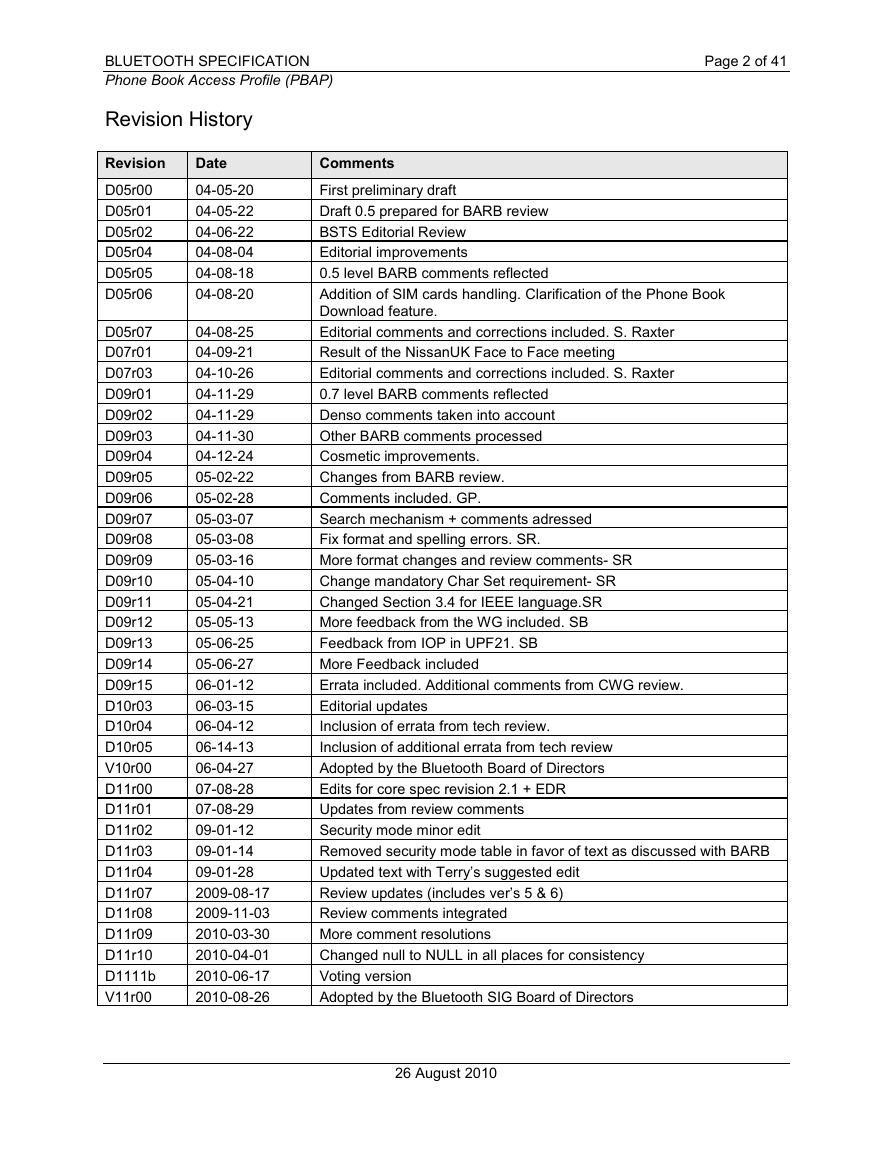
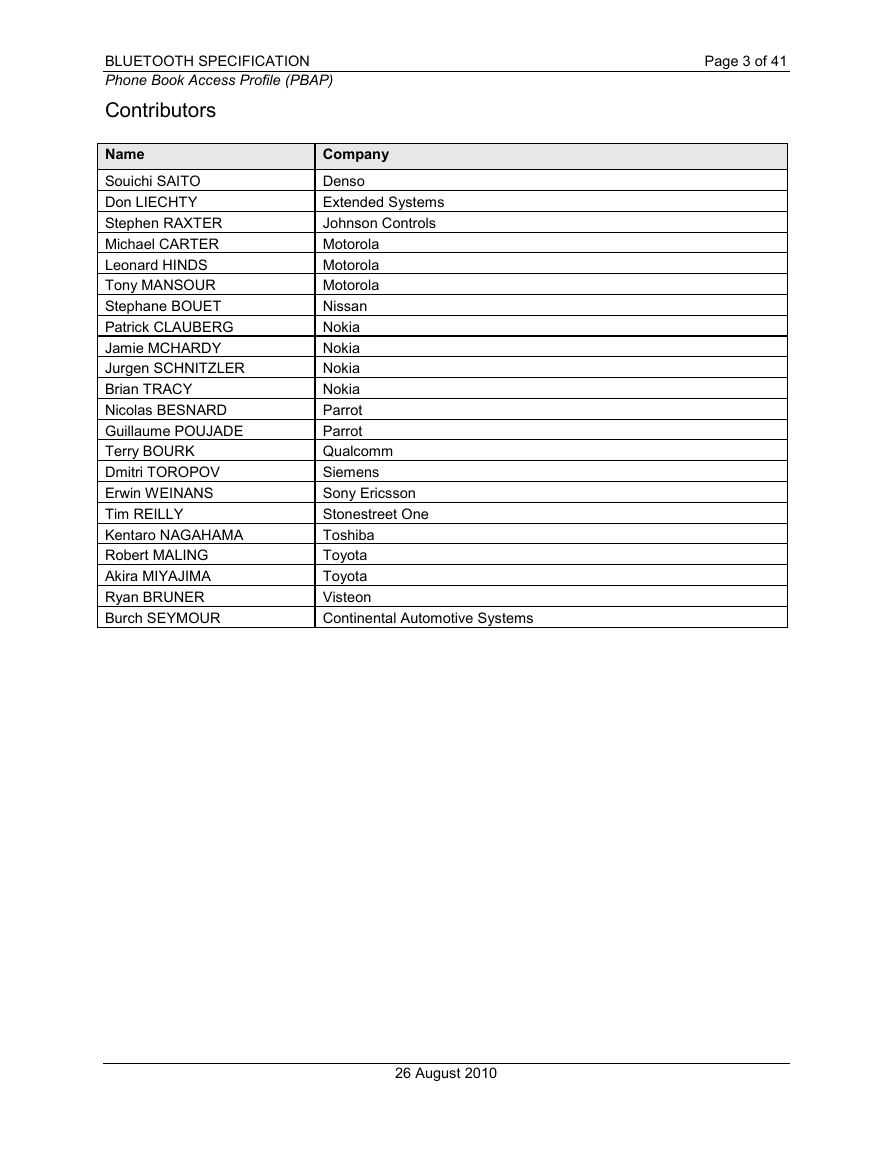
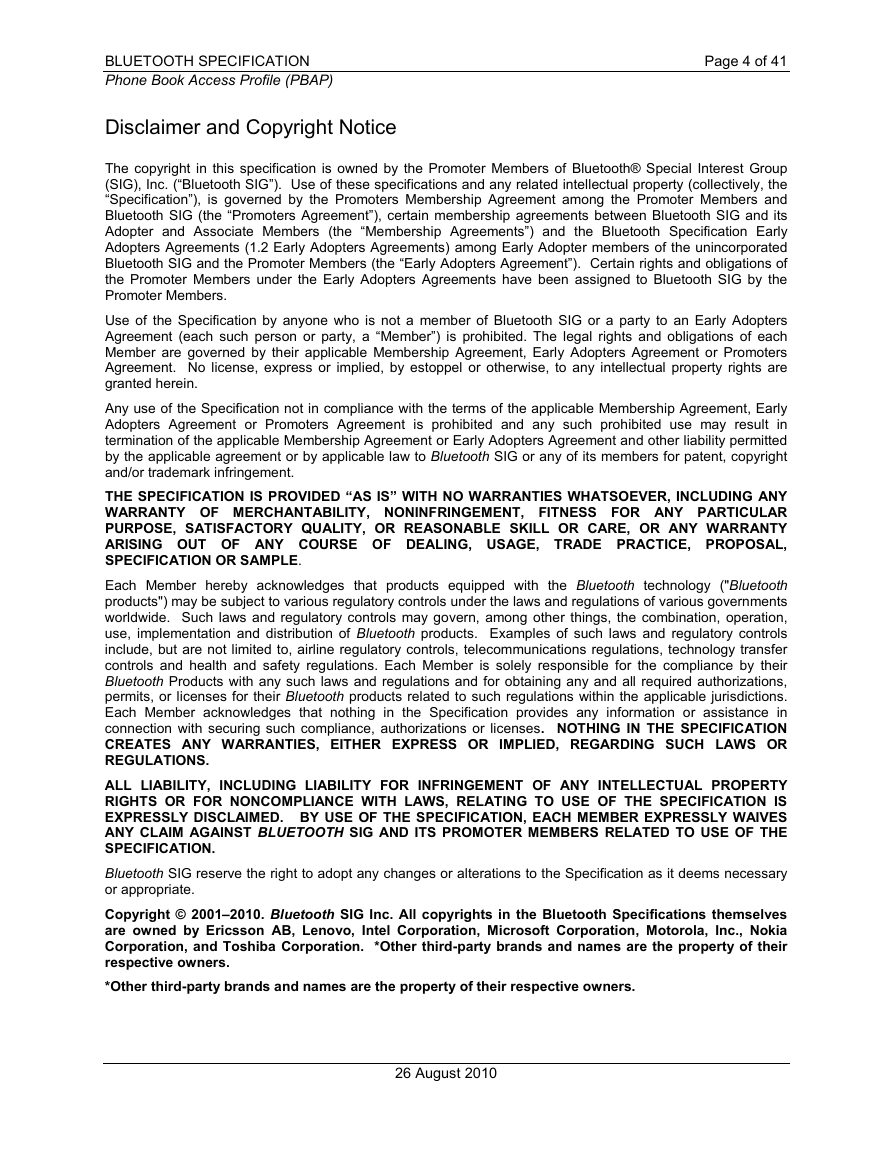
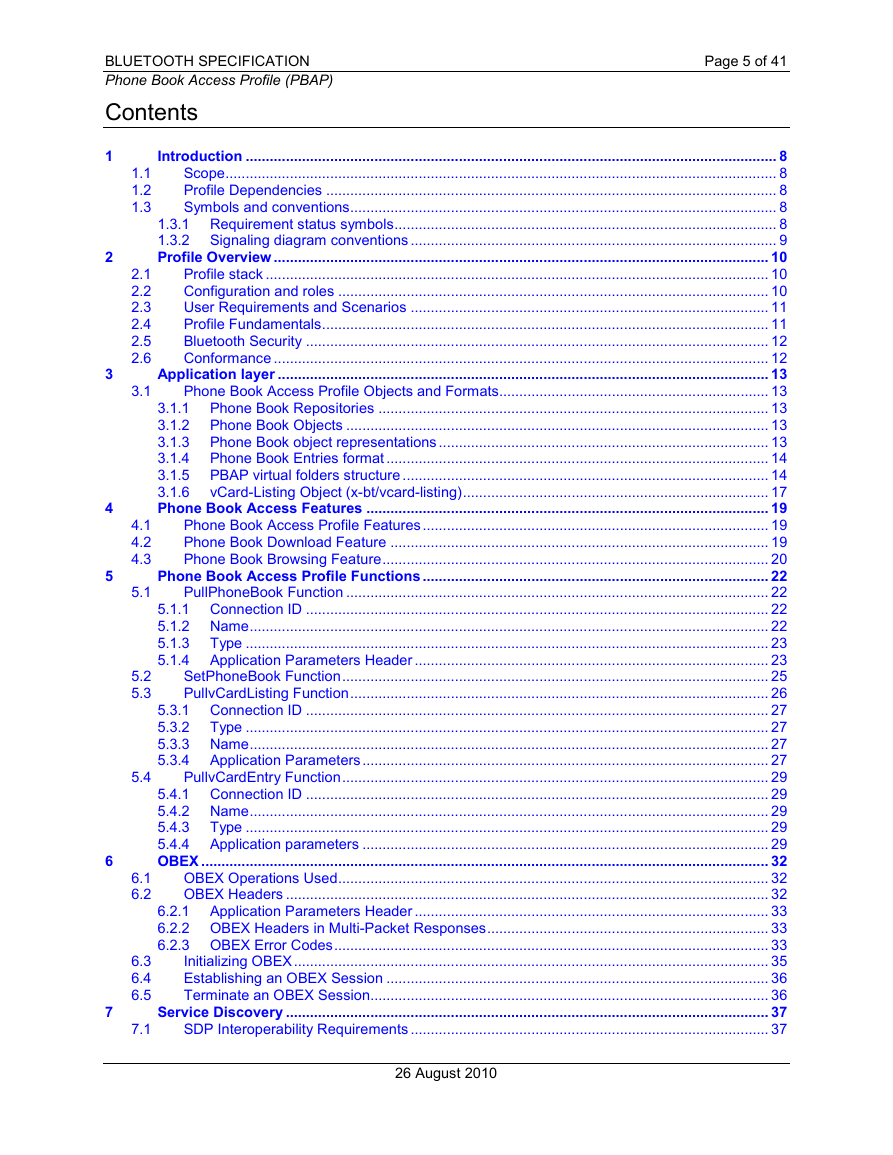
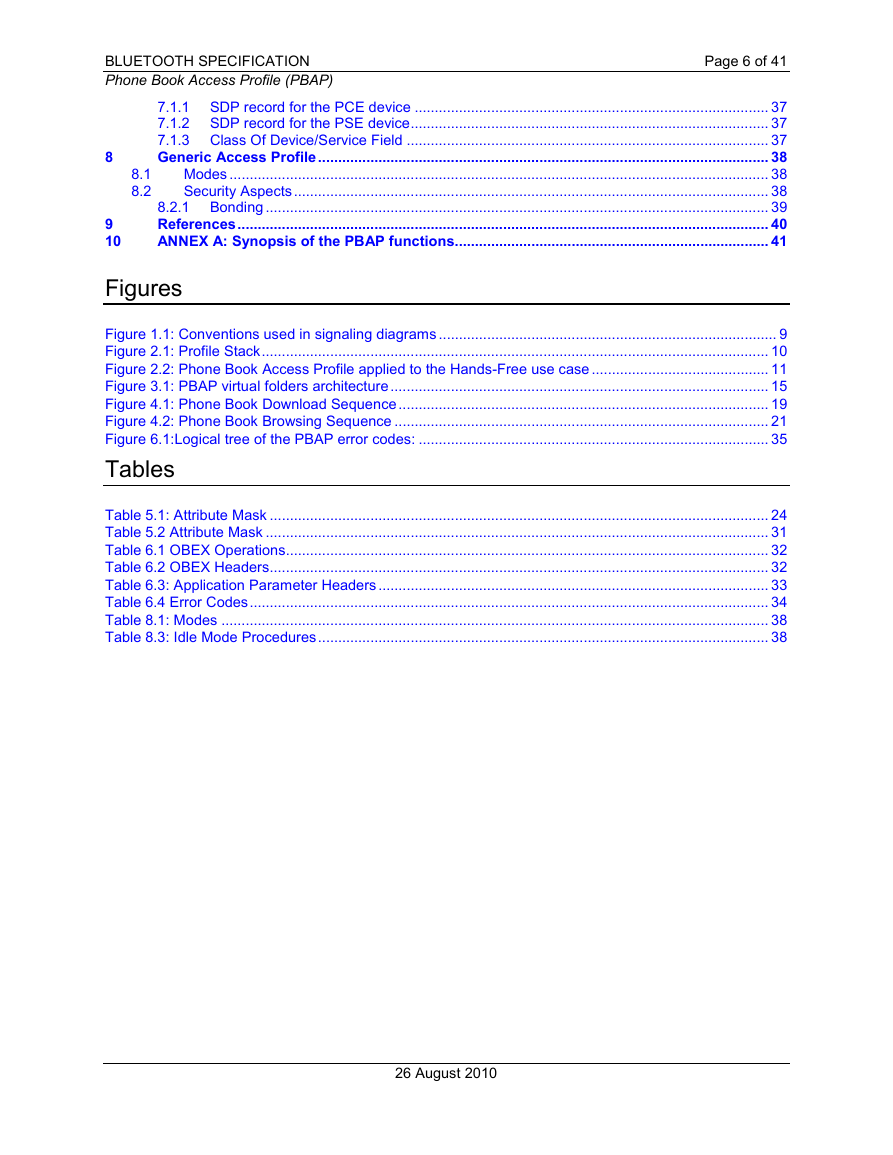
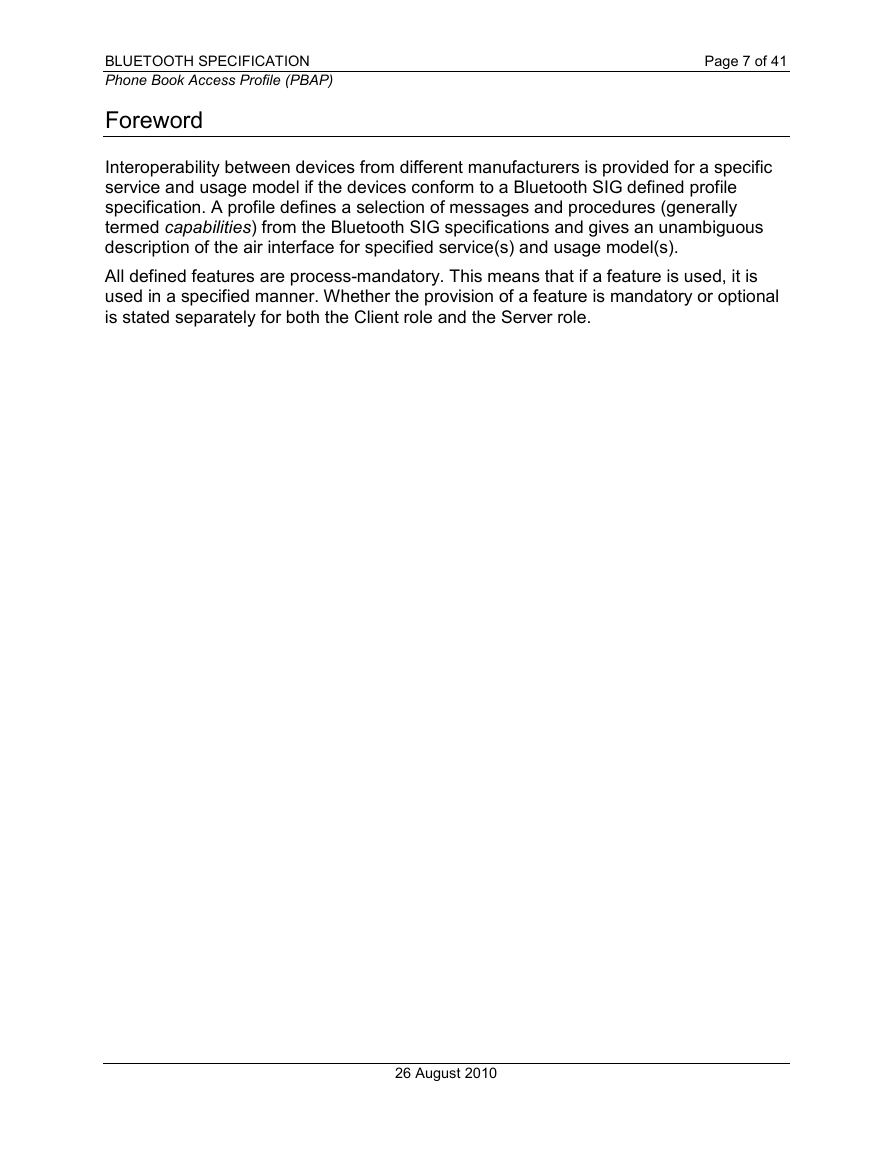
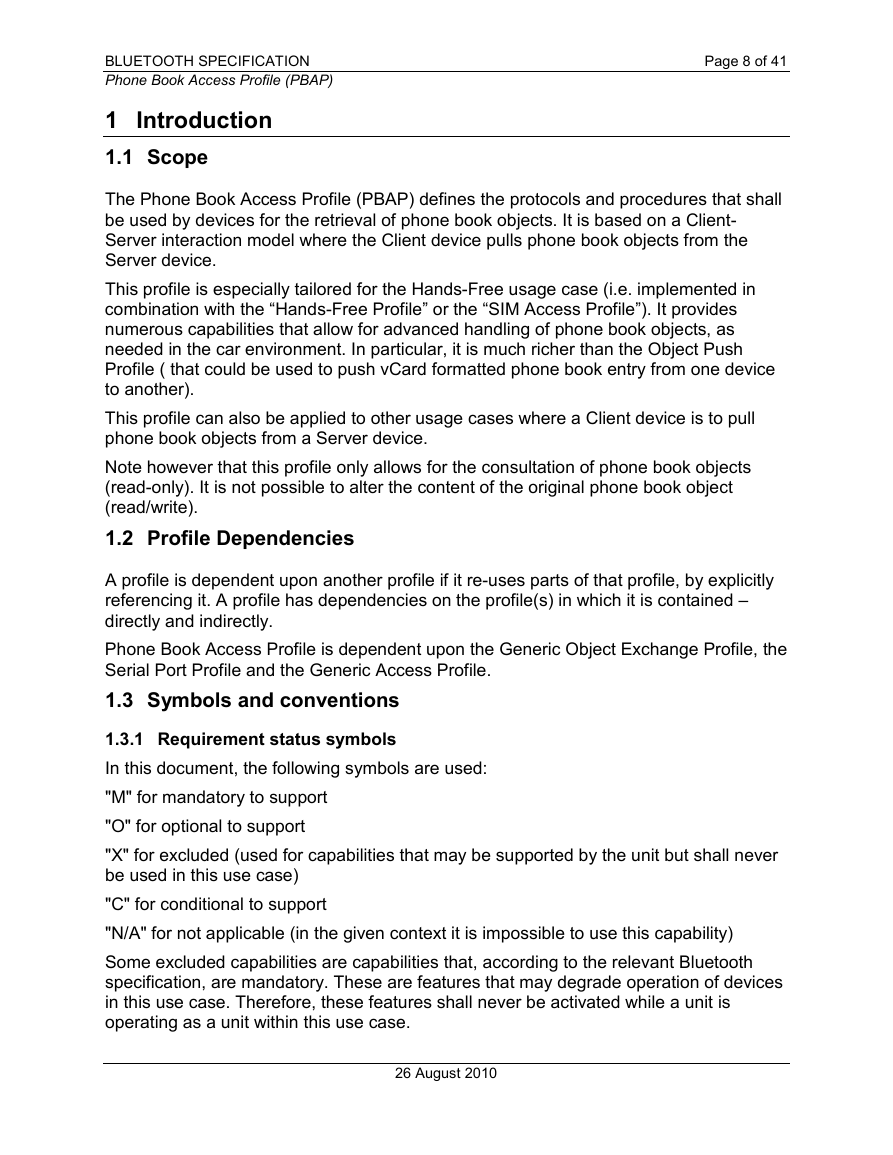








 2023年江西萍乡中考道德与法治真题及答案.doc
2023年江西萍乡中考道德与法治真题及答案.doc 2012年重庆南川中考生物真题及答案.doc
2012年重庆南川中考生物真题及答案.doc 2013年江西师范大学地理学综合及文艺理论基础考研真题.doc
2013年江西师范大学地理学综合及文艺理论基础考研真题.doc 2020年四川甘孜小升初语文真题及答案I卷.doc
2020年四川甘孜小升初语文真题及答案I卷.doc 2020年注册岩土工程师专业基础考试真题及答案.doc
2020年注册岩土工程师专业基础考试真题及答案.doc 2023-2024学年福建省厦门市九年级上学期数学月考试题及答案.doc
2023-2024学年福建省厦门市九年级上学期数学月考试题及答案.doc 2021-2022学年辽宁省沈阳市大东区九年级上学期语文期末试题及答案.doc
2021-2022学年辽宁省沈阳市大东区九年级上学期语文期末试题及答案.doc 2022-2023学年北京东城区初三第一学期物理期末试卷及答案.doc
2022-2023学年北京东城区初三第一学期物理期末试卷及答案.doc 2018上半年江西教师资格初中地理学科知识与教学能力真题及答案.doc
2018上半年江西教师资格初中地理学科知识与教学能力真题及答案.doc 2012年河北国家公务员申论考试真题及答案-省级.doc
2012年河北国家公务员申论考试真题及答案-省级.doc 2020-2021学年江苏省扬州市江都区邵樊片九年级上学期数学第一次质量检测试题及答案.doc
2020-2021学年江苏省扬州市江都区邵樊片九年级上学期数学第一次质量检测试题及答案.doc 2022下半年黑龙江教师资格证中学综合素质真题及答案.doc
2022下半年黑龙江教师资格证中学综合素质真题及答案.doc